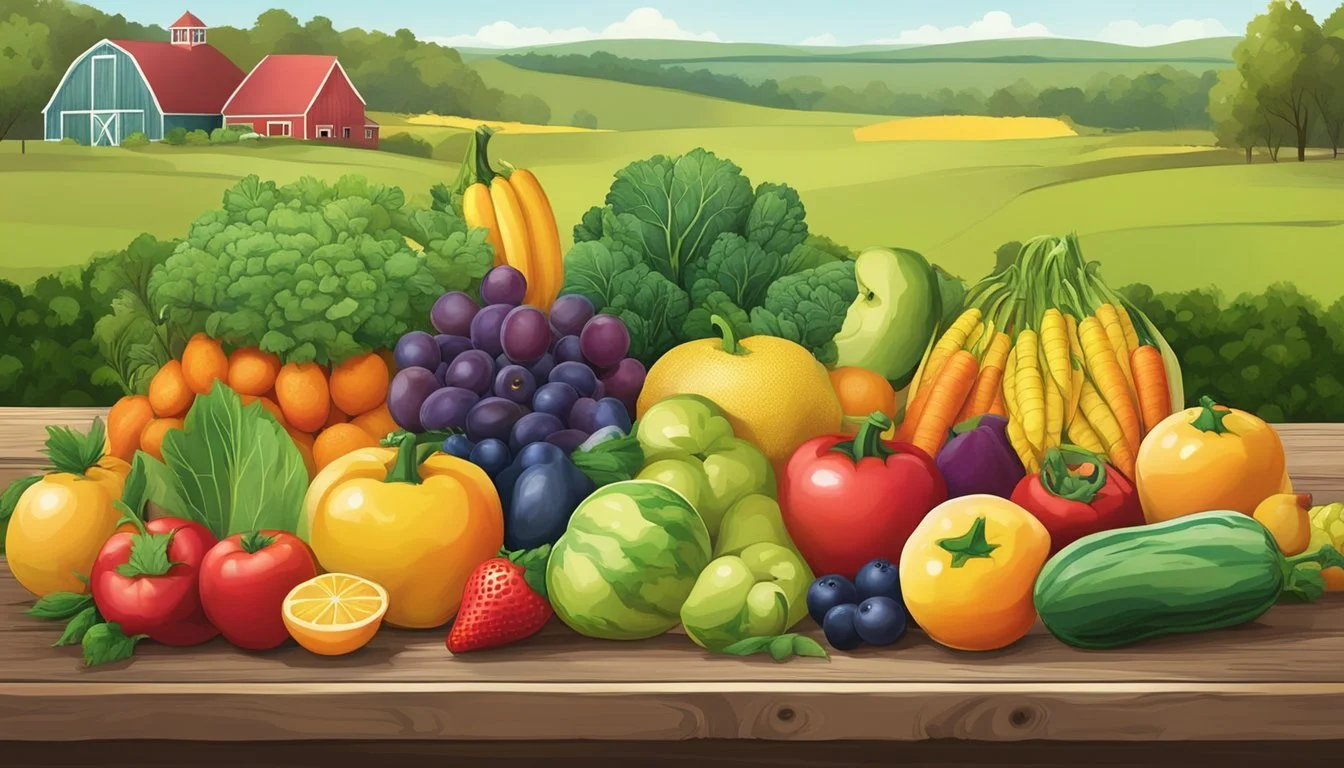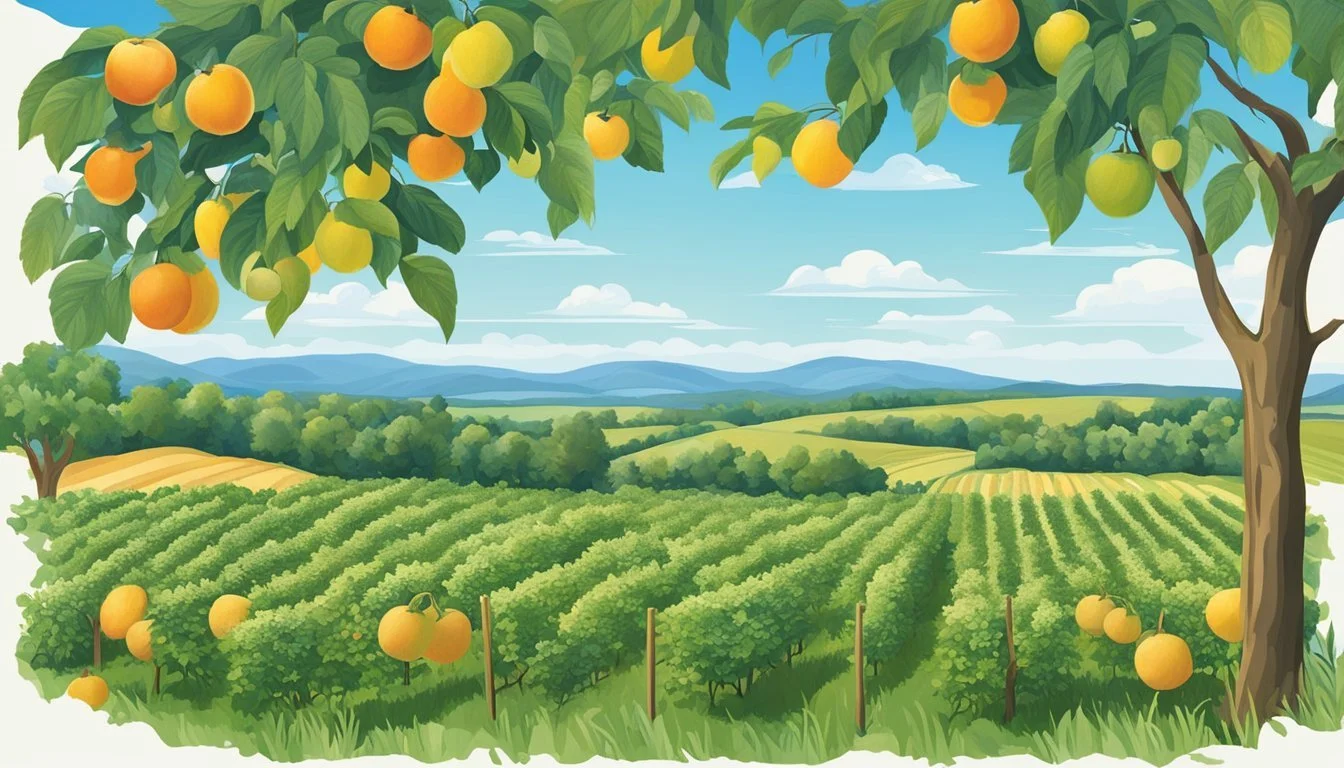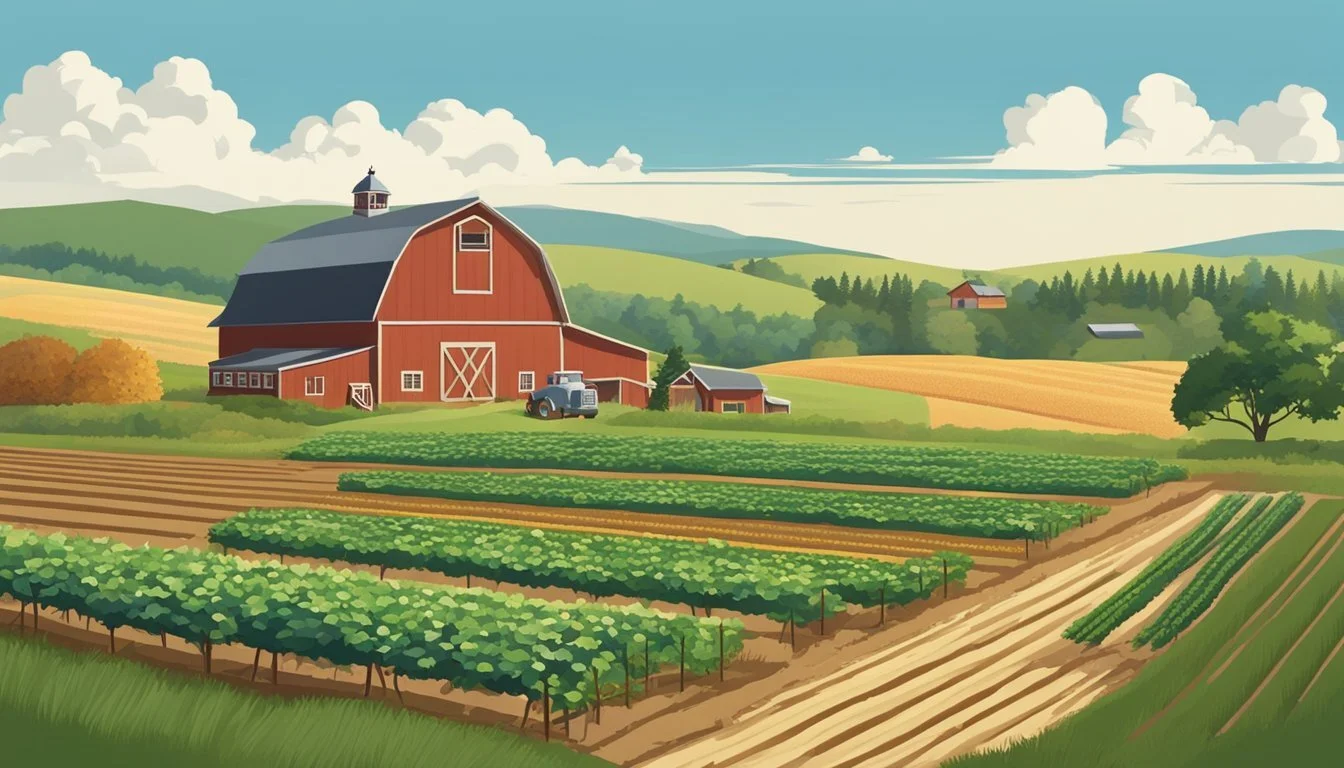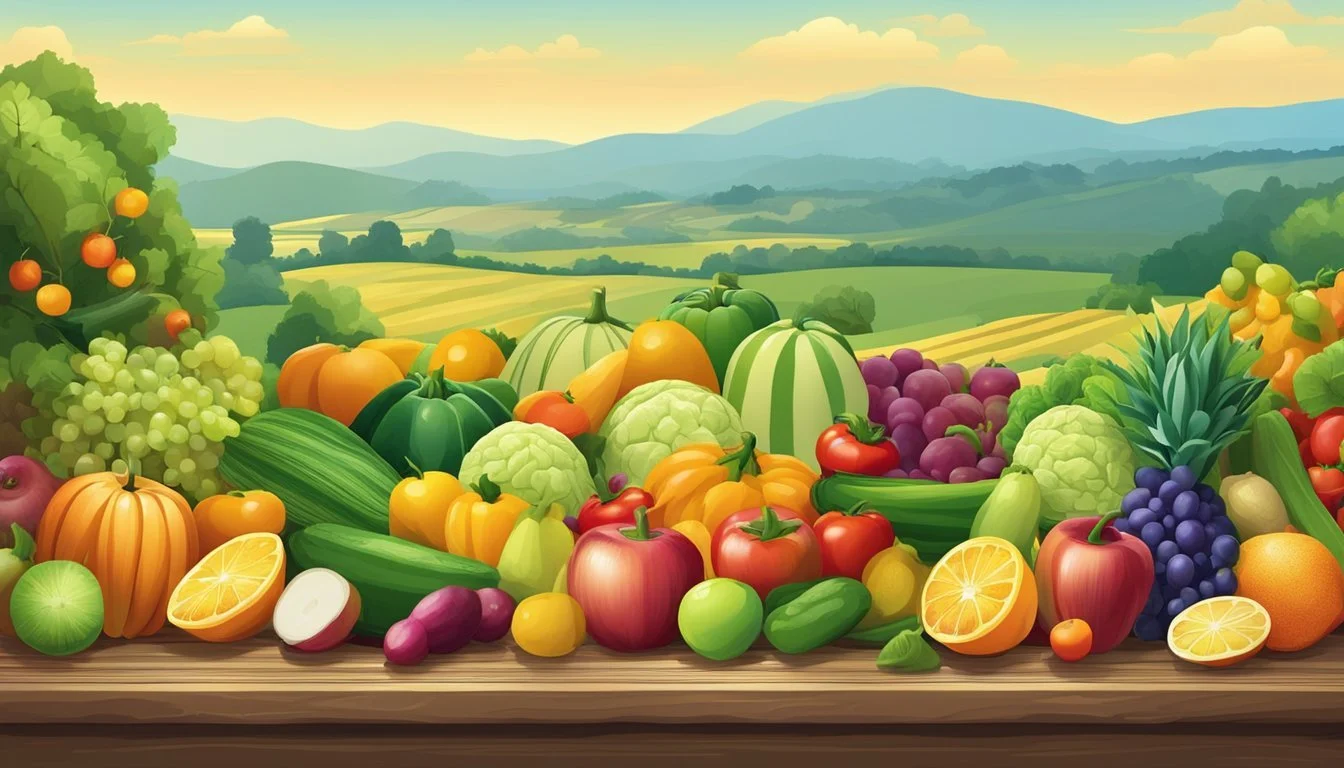Michigan Seasonal Fruit & Veg Guide
Your Year-Round Companion
Michigan's diverse climate paves the way for a rich variety of fruits and vegetables throughout the year, each season offering its own bounty. From the lush summer harvest of cherries and blueberries (how long do blueberries last?) to the crisp autumnal apples and pumpkins, the state's agricultural calendar brims with opportunities for farm to table freshness. Seasonality is the cornerstone of Michigan's produce, with each period ensuring peak flavor, nutrition, and local economic support.
As a guide through the state's seasonal offerings, it's essential to understand the growing timelines and harvest windows that define Michigan's farm to table landscape. Knowledge of this schedule not only enhances the culinary experience but also supports sustainable practices by tapping into locally grown resources. For the discerning consumer or culinary enthusiast, aligning meals with Michigan's harvest calendar ensures a meal replete with the freshest ingredients.
Farmers across Michigan work in concert with the seasons, adhering to the natural growth cycles of their crops to deliver the freshest produce to the market. The state's rich soil and distinct seasons shape a unique environment where fruits and vegetables can thrive. Awareness of when each variety reaches its peak can transform the way Michigan locals and visitors alike approach their food, fostering a connection to the land and the rhythm of its yield.
What’s in Season in Michigan Right Now?
Michigan’s Growing Seasons
In Michigan, the weather plays a vital role in determining the growing seasons of various fruits and vegetables. The state's climate, which includes cold winters and warm summers, is conducive to a diverse range of produce.
Spring brings the onset of Michigan's growing season with hardy greens and root vegetables. As early as April, residents can find asparagus (how long does asparagus last?), leafy greens, and herbs sprouting in fields. May ushers in the availability of potatoes and rhubarb.
Summer boasts the peak of Michigan's productivity with an assortment of fruits and vegetables:
July to September: The warm summer months are prime for harvesting juicy nectarines, peaches, and cantaloupes (how long does cantaloupe last?).
Mid June to July: This period is well-known for the sweet taste of cherries.
As autumn approaches, the state sees a variety of vegetables being harvested:
August to October: This time is ideal for broccoli, cabbage, and chestnuts.
September: The transition into fall marks the return of favorites like cucumbers (how long do cucumbers last?).
While many crops are harvested during specific months, some like herbs and various greens span multiple seasons, ranging from April through to October.
Winter is quieter in terms of growing seasons; however, the state's robust greenhouse operations allow certain produce to be available year-round.
Certainly, Michigan's diverse weather patterns and distinct seasons create an environment where a rich variety of fruits and vegetables can be grown and harvested, providing a stable supply of fresh produce to local markets.
Spring Harvest
Michigan's spring harvest ushers in a rejuvenating palette of produce, characterized by tender, earthy flavors. These earlier months mark the arrival of fresh greens and the beginning of a fruitful growing season.
April Delights
In April, Michigan farmers' markets begin to showcase asparagus, one of the state's first spring vegetables. This perennial thrives in the cool temperatures of early spring, making it a staple at this time of year.
Asparagus: Expect crisp stalks perfect for steaming, grilling, or roasting.
Greens: Various cold-hardy greens like spinach and kale are also available, offering a burst of freshness to spring dishes.
May Bounty
May brings a wider variety of produce as the Michigan soil warms. Fresh peas and rhubarb stand out during this month, each adding unique flavors and textures to the spring table.
Peas: Look for plump pods of garden peas, sugar snap peas, and snow peas.
Rhubarb: Recognizable by its crimson stalks, rhubarb is typically harvested in May and often used in sweet desserts like pies and compotes.
Spotlight on greens continues in May, with an abundance that includes:
Arugula
Lettuce
Mustard Greens
These young, tender greens are ideal for salads and light sautéing, presenting not only a taste of the season but also a wealth of nutrients.
Summer Abundance
Summer in Michigan is a period of bountiful harvests, where an array of fruits and vegetables reach their peak ripeness. This season offers the freshest flavors from local farms to the table, with a colorful selection from berries to stone fruits and vibrant vegetables.
June Selection
In June, strawberries make a sweet entrance, signaling the start of summer with their bright red color and juicy taste. The market also sees the start of the cherry season, with both sweet and tart varieties available. Early blueberries start to appear, alongside verdant vegetables like cucumbers and various beans which begin to swell on their vines, ready for harvest.
Fruits: Strawberries, Cherries, Blueberries (begin)
Vegetables: Cucumbers, Beans (begin)
July Harvest
July marks the peak of cherry harvesting, with blueberries following close behind in abundance, perfect for jams, pies, or fresh consumption. The sun-loving raspberries burst into the scene, while peaches and nectarines herald the true essence of a Michigan summer with their fuzzy skins and juicy sweetness. Alongside these fruits, vegetable gardens are thriving, showcasing ripe tomatoes, peppers, and eggplant (What wine goes well with eggplant?) that come into full play for a variety of summer dishes.
Fruits: Cherries, Blueberries, Raspberries, Peaches, Nectarines
Vegetables: Tomatoes, Peppers, Eggplant
August Peak
As summer progresses, August sees a continuation of peach and nectarine availability, while adding watermelon and cantaloupe to the mix, offering a refreshing respite from the summer heat. Blueberries and raspberries are still going strong. On the vegetable front, this is the prime time for corn, sweet and perfect for grilling or boiling. Tomatoes and cucumbers continue to thrive, ensuring a steady supply for salads and sandwiches.
Fruits: Peaches, Nectarines, Watermelon, Cantaloupe, Blueberries (continue), Raspberries (continue)
Vegetables: Corn, Tomatoes (continue), Cucumbers (continue)
Autumn Harvest
Michigan's autumn months offer a bounty of fresh fruits and vegetables. Farmers and gardeners reap the rewards of the growing season as cooler temperatures set in.
September Yield
September in Michigan ushers in the harvest of a variety of produce. The list below highlights key fruits and vegetables available this month:
Apples: A staple of Michigan's fall harvest, varieties like Honeycrisp and McIntosh become ready for picking.
Squash: Varieties such as acorn and butternut squash reach their peak.
Pears: Bartlett and Bosc pears are typically ripe and ready for harvest.
Broccoli: This cool-season crop thrives in the fall and is harvested in September.
Fruit/Vegetable Availability Apples Peak Season Squash Peak Season Pears Peak Season Broccoli Harvested
October Fruits
October's cooler days continue to yield fall favorites, with a focus on these fruits:
Pumpkins: Synonymous with fall, they are harvested in October for decoration and cooking.
Apples: Offer several late-season varieties that come into their prime.
Fruit Availability Pumpkins Peak Season Late-Season Apples Peak Season
During these autumn months, visitors to Michigan's farms can find the freshest local produce and participate in the rich tradition of farm to table eating.
Winter Offerings
During Michigan's cold months, local farms still offer a variety of fresh produce, ensuring tables are graced with nutritious options. Winter squash, a staple of the winter season, comes in varieties such as butternut, acorn, and spaghetti. These squashes are versatile in the kitchen, perfect for warming soups, hearty stews, or simply roasted.
Cabbage thrives in cooler weather, and Michigan offers an array of types, including green, red, and savoy. It is a popular ingredient in dishes like coleslaw and has a long shelf-life, making it an excellent choice for winter storage.
Turnips are a hearty root vegetable commonly available in winter months. They can be used in a multitude of ways, from roasting for a sweet, caramelized side dish, to being mashed like potatoes for a lower-carb alternative.
Winter Produce Description Culinary Uses Winter Squash Sweet, nutty flavor; firm texture Soups, roasts, purees Cabbage Crisp and slightly bitter Slaws, soups, stir-fries Turnips Earthy, with a hint of bitterness Roasted, mashed, or raw salads
Lastly, chestnuts are not only a festive treat but are also harvested in Michigan winters. These sweet, starchy nuts (how long do nuts last?) are perfect for roasting on an open fire or incorporating into holiday recipes.
Farmers in Michigan utilize greenhouses, hoop houses, and cold storage to extend the availability of these crops, ensuring that consumers can enjoy local produce even in the deepest of winter.
Farmers Markets and Farm Stands
Michigan's agriculture is robust and diverse, providing a plethora of seasonal fruits and vegetables available at various farm markets and stands. Farmers from all over the state bring their freshest produce to local farm markets, ensuring that consumers have access to quality, locally-grown food.
Farmers Markets: These are the hubs of local produce, often open one or more days a week during the growing season. City-based markets like the Kalamazoo Farmer's Market operate on select weekdays and Saturdays, offering a range from traditional produce to artisanal goods. Markets typically scale their operations depending on the season, with some, such as the Kalamazoo market, expanding market days in the summer months to accommodate the influx of seasonal fruits and vegetables.
Farm Stands: For a more direct farm-to-table experience, farm stands dotted across Michigan's rural landscape provide a more intimate purchasing experience. Shoppers can often meet the farmers and learn more about the growing practices directly. Unlike farmers markets, some farm stands may be open daily, allowing for greater flexibility in shopping for fresh produce.
Location and Accessibility: The Michigan Farmers Market Association offers a user-friendly way to locate nearly 300 farmers markets across the state. Consumers can search based on their city, zip code, or the desired day of the week to find a convenient market or farm stand.
List of Key Produce and their Availability at Michigan Farmers Markets and Farm Stands:
Cherries (how long do cherries last?): Look for them mid-summer, as they are not typically available year-round.
Blueberries: Prime blueberry season is during the warmer months.
Apples: Fall is the quintessential time for Michigan apples.
Corn: Best enjoyed in late summer when it’s harvested fresh.
Shoppers interested in farm-to-table dining will find that Michigan's farmers markets and farm stands are essential destinations for sourcing the best local produce the state has to offer.
Farm to Table Resources
This section outlines specific resources for embracing Michigan's seasonal produce. It encompasses local recipes tailored to seasonal availability, tips for preserving fruits and vegetables to extend their freshness, and educational activities to engage with farm-to-table practices.
Local Recipes
Local chefs and home cooks in Michigan utilize a wealth of seasonal fruits and vegetables to create nutritious and flavorful dishes. They often share their culinary creations on various platforms, including Instagram and local food blogs, providing a trove of recipes for the community. The resources include Michigan Farm Fun, where one can find a collection of recipes connecting them to local produce, and Michigan Harvest to Table, offering resources aligned with US Dietary Guidelines to promote the consumption of seasonal produce.
Preservation Tips
When it comes to preserving the bounty of Michigan's harvest, techniques such as drying and canning are invaluable. These methods ensure that the surplus of seasonal produce can be enjoyed throughout the year. Extensive guides and data on preservation are readily available through Michigan's agricultural support entities, which provide detailed instructions on safe and effective preservation.
Educational Activities
Farm-to-table isn't just a business; it's a means to educate and inspire individuals about the food they consume. Michigan offers a range of educational activities, including farm visits and culinary tours, designed to provide hands-on experiences. These activities are highlighted through resources like Michigan Agritourism Association's Seasonal Farm Fun Guide and the Farm Fresh Produce Calendar at Michigan Farm Fun, which equip educators with tools to impart knowledge about healthy eating and local agriculture.
Seasonal Farm Events
Michigan's farm-to-table scene offers an array of seasonal events that showcase the state's rich agricultural heritage. From spring festivities to winter markets, local farms provide an opportunity for visitors to engage directly with the source of their food.
Spring Festivities
In spring, Michigan farms host events like the opening of farmers markets and planting festivals. Visitors can partake in activities such as hands-on gardening workshops and meet the local farmers planting the seeds for the upcoming season's harvest. Often, these events coincide with the first bursts of produce like strawberries, giving a fresh taste of what's to come.
Summer Tours
The summer months are peak times for agri-tourism in Michigan. Many farms open their gates for tours and U-pick activities, allowing visitors to harvest their own fruits and vegetables. Popular destinations include cherry orchards and berry fields. This is also the time of year for exploring corn mazes and enjoying the festivities at a local cider mill.
Autumn Celebrations
Autumn in Michigan is synonymous with harvest celebrations. Farms transform into vibrant venues offering pumpkin picking, hayrides, and autumnal farmers markets. A highlight is the bountiful harvest of apples, where cider mills become community hubs, pressing fresh cider and offering donuts (how long do donuts last?). Many farms also host fall festivals featuring live music and local produce.
Winter Markets
Even in the chill of winter, Michigan's farm-to-table event calendar continues. Winter markets move indoors, offering locally grown produce like squash and greenhouse-grown greens. Some farm markets also offer holiday-themed events, giving the communities a chance to support their local farmers and find unique, hand-crafted gifts for the season.
Environmental and Economic Impact
Michigan's agriculture, especially in terms of produce, plays a significant role in both the environmental sustainability and the economic vitality of the state. Produce farming has environmental impacts that vary by crop and farming practices; however, a focus on sustainable agriculture aims to mitigate negative effects.
Economic Contributions: Michigan's agriculture is a cornerstone of its economy, generating over $100 billion annually. This includes the economic activity from backward linked industries related to fruit production.
Sustainability Efforts: Fruit and vegetable growers are increasingly adopting sustainable practices, reducing water usage, and minimizing chemical inputs, thus enhancing Michigan's ecological health.
Local Economy Support: The farm-to-table movement supports Michigan’s local economy by encouraging grocery stores and restaurants to source directly from local farms. This reduces transportation emissions and helps maintain a robust local workforce. Direct farm-to-consumer sales further invigorate the economy.
Climate Adaptations: Farmers are adapting to climate changes, with some shifting their crop selections or altering practices to maintain productivity in the face of changing weather patterns. This adaptability not only protects the environment but also ensures the stability of the local economy.
The direct economic impact of fruit production alone in Michigan is substantial, with a direct economic contribution of $485.44 million and a total economic activity of $753.01 million.
By fostering a local food system, Michigan strengthens community resilience and contributes positively to both environmental and economic sustainability.
Key Takeaways
Michigan's diverse climate allows for a wide variety of fruits and vegetables to thrive. Seasonal availability is crucial for anyone interested in farm-to-table eating habits. Commonly, one may find berries during Michigan's warm summer months. Strawberries appear by the end of May, giving way to cherries, blueberries, blackberries, and raspberries as summer progresses.
They can expect a different bounty in the fall. Squash and root vegetables like rutabagas and parsnips are harvested late in the year, alongside hearty greens such as spinach. For winter squash and pumpkin enthusiasts, they're typically harvested in early autumn but can often last through the Michigan winter if stored properly.
Season Fruits Vegetables Summer Cherries, Blueberries, Raspberries Spinach, Sweet Corn Fall Apples, Pears Squash, Parsnips
It is encouraged to use the Michigan Harvest Calendar to keep track of availability. Eating with the seasons not only supports local Michigan farmers but also provides fresher, tastier, and more nutritious produce. Shoppers should consider frequenting local farmers' markets or subscribing to a CSA (Community Supported Agriculture) box for regular, seasonal produce.
Michigan's climate also impacts the flavor of its produce. Soil and weather conditions can contribute to sweeter, more flavorful fruits and vegetables, so one can anticipate exceptional taste when eating locally-sourced items in season.









